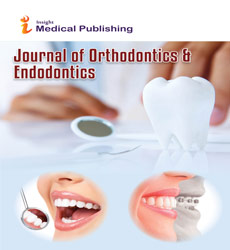Regenerative Endodontics: Emerging Trends and Future Perspectives
Irham Jebat
Department of Dentistry, The University of Hong Kong, Hong Kong SAR 999077, China
Published Date: 2025-02-24*Corresponding author:
Irham Jebat,
Department of Dentistry, The University of Hong Kong, Hong Kong SAR 999077, China.
E-mail: Jebat.irham@connect.hku.hk
Received date: February 03, 2025, Manuscript No. IPJOE-25-20725; Editor assigned date: February 05, 2025, PreQC No. IPJOE-25-20725 (PQ); Reviewed date: February 10, 2025, QC No IPJOE-25-20725; Revised date: February 17, 2025, Manuscript No IPJOE-25-20725 (R); Published date: February 24, 2025.DOI: 10.36648/2469-2980.11.1.04
Citation: Jebat I (2025) Regenerative Endodontics: Emerging Trends and Future Perspectives. J Orthod Endod Vol.11 No.1:04
Introduction
Endodontics, a specialized branch of dentistry dealing with the study and treatment of the dental pulp and periapical tissues, has undergone significant transformations over the years. Traditionally, root canal therapy has served as the primary approach to treating infected or necrotic pulp tissues, aiming to eliminate bacteria, disinfect the root canal system and preserve the function of the tooth. While conventional root canal treatment has been largely successful in saving teeth, it does not restore the vitality of the pulp or regenerate dentin and other supporting tissues. This limitation has paved the way for the emergence of regenerative endodontics, a rapidly evolving field that seeks to restore both the form and function of dental tissues through biological and tissue engineering approaches. Regenerative endodontics focuses on healing and rebuilding the pulpâ??dentin complex, promoting root maturation in immature teeth and even potentially reversing pulpal necrosis. It integrates knowledge from stem cell biology, molecular signaling, biomaterials and clinical innovations, offering exciting opportunities to shift from mere disease management to functional tissue regeneration. As dentistry increasingly embraces personalized and biologically driven care, regenerative endodontics represents a frontier that could redefine the future of dental treatment and patient outcomes [1].
Description
The concept of regenerative endodontics emerged from the limitations of traditional root canal therapy. A tooth that has undergone endodontic treatment becomes devitalized, losing its natural defense mechanisms, ability to sense external stimuli and capacity for continued root development in immature teeth. This can make the tooth more fragile and susceptible to fracture in the long term.
Regenerative endodontics addresses these limitations by harnessing biological principles to revitalize the pulp and regenerate dentin, thereby restoring natural vitality and extending the life of the tooth. At its core, regenerative endodontics relies on three fundamental components often described as the tissue engineering triad: stem cells, signaling molecules and scaffolds. Stem cells provide the cellular source necessary for tissue regeneration, signaling molecules such as growth factors guide cellular differentiation and proliferation and scaffolds serve as a structural framework to support tissue development [2].
One of the earliest and most widely studied regenerative endodontic procedures is revascularization, which involves inducing bleeding into the disinfected root canal system to create a blood clot that serves as a natural scaffold for stem cells to migrate into and differentiate. Clinical studies have demonstrated that this approach can lead to continued root maturation, thickening of dentin walls and in some cases, restoration of pulp vitality. However, the outcomes of revascularization are not always predictable and the regenerated tissue may not fully resemble natural pulp in its composition or function. Despite these limitations, revascularization has laid the foundation for more sophisticated strategies in regenerative endodontics [1].
Stem cell-based approaches hold immense promise for advancing regenerative therapies. Dental Pulp Stem Cells (DPSCs), stem cells from the Apical Papilla (SCAP), Periodontal Ligament Stem Cells (PDLSCs) and Bone Marrow-Derived Mesenchymal Stem Cells (BM-MSCs) are among the most studied cell types for endodontic applications. These stem cells have demonstrated the ability to differentiate into odontoblast-like cells that can produce dentin, as well as other cell types that contribute to pulp regeneration. Recent research has also focused on induced Pluripotent Stem Cells (iPSCs), which offer the potential to generate patient-specific stem cells for personalized regenerative therapies. The use of stem cells in endodontics raises important considerations related to delivery methods, cell survival, immune compatibility and ethical concerns, but advances in biotechnology continue to refine their clinical potential [2].
Conclusion
Regenerative endodontics represents a paradigm shift in the way dental professionals approach the treatment of pulp and periapical diseases. Moving beyond the traditional goal of disease elimination, it aims to restore the vitality, function and natural defenses of the tooth through biologically driven therapies. By leveraging the potential of stem cells, scaffolds and signaling molecules, regenerative approaches offer the possibility of achieving true tissue regeneration rather than mere repair. Although challenges remain in terms of predictability, standardization, cost and ethical considerations, the rapid pace of research and innovation provides optimism for the future.
As clinical protocols evolve and emerging technologies such as nanotechnology, gene therapy and 3D bioprinting become more integrated into practice, regenerative endodontics has the potential to revolutionize dental care. Ultimately, the success of this field will not only extend the life of treated teeth but also enhance patient outcomes, marking a significant step forward in the convergence of dentistry and regenerative medicine.
Acknowledgment
None
Conflict of Interest
None
References
- Madan MS, Liu ZJ, Gu GM, King GJ (2007) Effects of human relaxin on orthodontic tooth movement and periodontal ligaments in rats. Am J Orthod Dentofac Orthop 131: e1-e10.
Google Scholar Cross Ref Indexed at
- Üretürk SE, Saraç M, Fıratlı S, Can Å?B, Güven Y, et al. (2017) The effect of low-level laser therapy on tooth movement during canine distalization. Lasers Med Sci 32: 757-764.
Open Access Journals
- Aquaculture & Veterinary Science
- Chemistry & Chemical Sciences
- Clinical Sciences
- Engineering
- General Science
- Genetics & Molecular Biology
- Health Care & Nursing
- Immunology & Microbiology
- Materials Science
- Mathematics & Physics
- Medical Sciences
- Neurology & Psychiatry
- Oncology & Cancer Science
- Pharmaceutical Sciences
